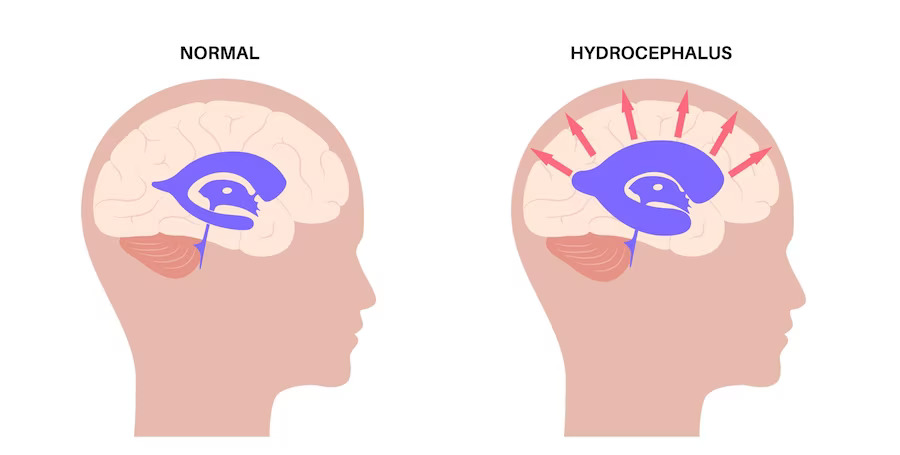Hydrocephalus is a medical condition that affects the brain and can be potentially life-threatening if left untreated. The term “hydrocephalus” refers to the accumulation of cerebrospinal fluid(CSF) in the brain, which can cause pressure and damage to brain tissue.
CSF is a clear fluid that surrounds the brain and spinal cord, providing cushioning and nutrients to these structures. In a healthy individual, the CSF is produced in the brain’s ventricles and is continuously circulating and reabsorbed. In hydrocephalus, there is an imbalance between the production and absorption of CSF, leading to an accumulation of fluid in the ventricles.
There are two main types of hydrocephalus: congenital and acquired. Congenital hydrocephalus is present at birth and is often caused by genetic factors or problems during fetal development. Acquired hydrocephalus can occur at any age and is typically caused by head injury, infection, tumor growth, or bleeding in the brain.
Symptoms of Hydrocephalus in the of 5 to 10 Years
The symptoms of hydrocephalus in children aged 5 to 10 can vary depending on the severity and cause of the condition. Here are some common symptoms to look out for:
- Headache: Children with hydrocephalus may experience frequent headaches that are often worse in the morning and improve throughout the day.
- Vomiting and nausea: Increased pressure in the skull can cause vomiting and nausea, especially in the morning.
- Vision problems: Hydrocephalus can put pressure on the optic nerve, causing visual disturbances such as double vision, blurred vision, or difficulty focusing.
- Behavioural changes: Children with hydrocephalus may experience irritability, lethargy, or difficulty with concentration and memory.
- Balance and coordination problems: Hydrocephalus can affect a child’s coordination and balance, leading to frequent falls or difficulty walking.
- Seizures: In some cases, hydrocephalus can lead to seizures.
- Developmental delays: If hydrocephalus is present from birth or develops early in life, it can affect a child’s development, leading to delays in reaching developmental milestones.
Causes of Hydrocephalus
- Congenital hydrocephalus: This type of hydrocephalus occurs when a baby is born with the condition. It can be caused by genetic abnormalities or developmental disorders that affect the formation of the brain and the flow of CSF.
- Acquired hydrocephalus: This type of hydrocephalus develops later in life, and can be caused by a variety of factors, such as:-
- Infections: Infections like meningitis, encephalitis, or ventriculitis can cause inflammation that blocks the flow of CSF.
- Tumours: Tumours in the brain or spinal cord can obstruct the flow of CSF, leading to hydrocephalus.
- Trauma: Head injuries can cause bleeding or swelling that disrupts the normal flow of CSF.
- Intracranial haemorrhage: Bleeding in the brain, such as from a stroke, can lead to hydrocephalus
- Normal pressure hydrocephalus: This is a type of hydrocephalus that occurs in older adults, and the cause is not well understood.
- Idiopathic hydrocephalus: In some cases, the cause of hydrocephalus is unknown, and this is called idiopathic hydrocephalus.
Treatments of Hydrocephalus
The treatment of hydrocephalus depends on the underlying cause and severity of the condition.but you should consult a experienced neurosurgeon, if you see any kind of symptoms stated above Here are some common treatments:-
- Shunt Surgery: This is the most common treatment for hydrocephalus. A shunt is a small tube that is placed in the brain to drain the excess cerebrospinal fluid and redirect it to another part of the body where it can be absorbed. Shunt surgery is usually a relatively simple procedure, and patients can often go home the same day.
- Endoscopic Third Ventriculostomy (ETV): This is a surgical procedure in which a small hole is made in the floor of the third ventricle of the brain to allow cerebrospinal fluid to flow freely, bypassing the obstruction. ETV is generally only suitable for certain types of hydrocephalus, and it may not be effective in all cases.
- Medications: Certain medications can be used to reduce the production of cerebrospinal fluid or to decrease the pressure in the brain. These medications may be used in conjunction with other treatments, such as shunt surgery.
- Supportive therapies: In some cases, patients with hydrocephalus may require additional supportive therapies, such as physical therapy, speech therapy, or occupational therapy to address any resulting physical or cognitive disabilities.
- Alternative therapies: There are some alternative therapies that may be used in conjunction with traditional treatments, such as acupuncture or biofeedback, to help manage symptoms and improve the overall quality of life. However, it is important to note that these therapies should not be used as a substitute for traditional medical treatment.





Leave A Comment